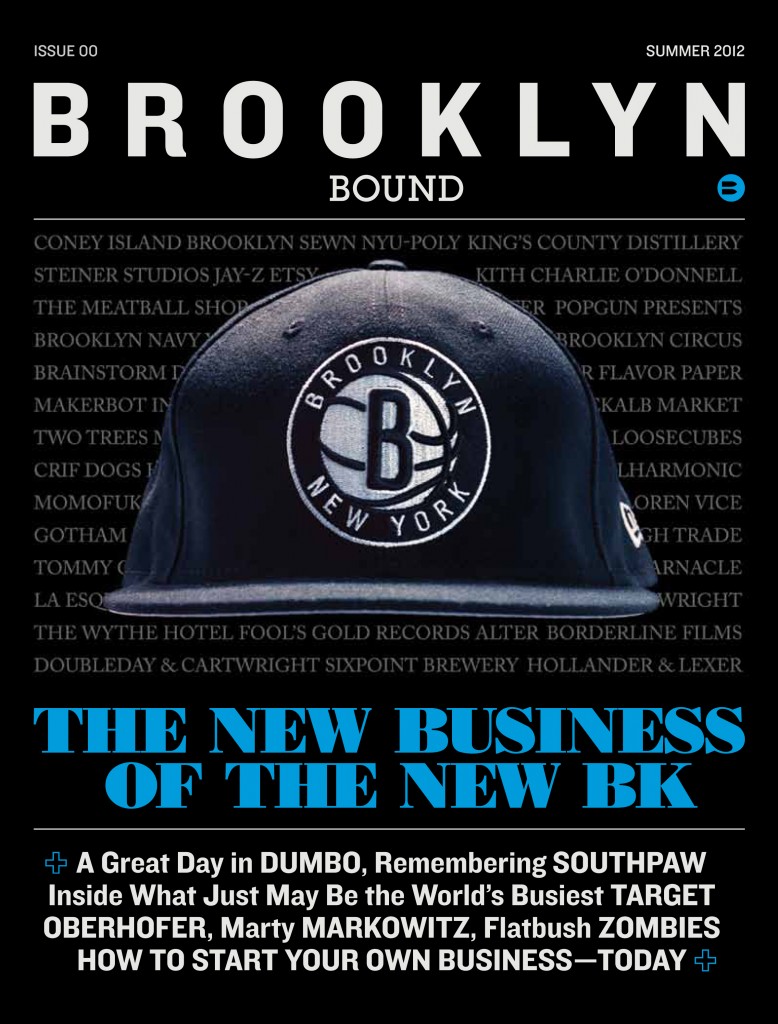 It has the population of the fourth largest city in the U.S., the cachet of being the trendiest place to call home in New York, and the brand envy of metropolitan areas the world over. Now all that Brooklyn needs, if not a return of the Dodgers to Ebbets Field, is a gazette—a publication of record that epitomizes the borough’s special appeal and carries the message to a loyal core of readers and advertisers.
It has the population of the fourth largest city in the U.S., the cachet of being the trendiest place to call home in New York, and the brand envy of metropolitan areas the world over. Now all that Brooklyn needs, if not a return of the Dodgers to Ebbets Field, is a gazette—a publication of record that epitomizes the borough’s special appeal and carries the message to a loyal core of readers and advertisers.
Brooklyn Bound aims to be that magazine. Launching this week, it’s a newcomer striving for editorial distinction in a market already well served by a variety of Brooklyn-centric periodicals and blogs. It’s also the embodiment of its founders’ belief that conventional print can more than hold its own in the e- and i-saturated media mix that contemporary Brooklyn represents.
The borough, with its rich cultural composition and its diversified business base, is fertile ground for magazine publishing, according to Benjamin Meadows-Ingram, the founding editor of Brooklyn Bound.
“There isn’t a bigger story in New York than what’s been happening in Brooklyn over the last five to 10 years,” he says. As the title implies, Meadows-Ingram says, the magazine’s mission will be to bind the strands into a continuum of coverage that engages readers “in a conversation that they haven’t had before.”
The conversation begins with the release of the inaugural Summer 2012 issue, now available for free pickup at more than a dozen non-newsstand outlets in Brooklyn and Manhattan (see the web site for the locations). For the time being, while Meadows-Ingram and his co-founders gauge response to the venture, the quarterly publication will have no cover price, postal circulation, or traditional single-copy distribution. The model will change as Brooklyn Bound gains traction with its intended audience, Meadows-Ingram says.
Although the audience consists primarily of young (18- to 44-year-old) Brooklynites, the team behind Brooklyn Bound is determined to give them more than just the über-hip lifestyle fare it sees as common to other media targeting this readership. That’s what’s said to distinguish the editorial spirit of Brooklyn Bound from the competition’s “boutique-focused” emphasis, which Meadows-Ingram regards as “catering to splinters of interest” instead of addressing the vibrancy of the borough as a whole.
Brooklyn, he maintains, is a natural laboratory in which to test the viability of local and hyperlocal publishing to small but highly desirable groups of readers and advertisers. “There is still a big hole in the market for regional publications,” says Meadows-Ingram, who has been a consumer and trade magazine editor for about 15 years. “That nut hasn’t been completely cracked.”
He adds that even if the Brooklyn magazine market—like the rest of the U.S. magazine industry—isn’t exactly “explosive” right now, there’s still plenty of potential for a journal that knows the streets and understands the aspirations of the people living and working on them.
In the first issue, says Meadows-Ingram, “we struck a balance” between life and work with a focus, as the coverline proclaims, on “the new business of the new Brooklyn” and the entrepreneurial personalities behind the borough’s economic upsurge.
There’s a photo essay, for example, presenting 40 people responsible for start-ups in the DUMBO district, and another about the retailing scene at the Atlantic Terminal Mall in Fort Greene. The aim of stories like these, Meadows-Ingram says, will be to “cover all of the economic strengths and weaknesses of the community.”
Brooklyn Bound does business of its own as an advertising-supported publication. The Summer 2012 issue, with a total folio of 100 pages, carries 20 pages of ads. Meadows-Ingram thinks that the magazine’s readership of creatives and “go-getters” should make the space particularly attractive to cultural institutions and schools, among other clientele.
Offset printing of the first issue was done by the YGS Group, a publishing and marketing solutions provider based in York, PA. Meadows-Ingram and his collaborators are convinced that the ink-on-paper palpability of Brooklyn Bound will be the bedrock of its appeal going forward.
They have all been in the print media business long enough to understand the upsides and the risks. Meadows-Ingram, for example, is music editor of Billboard and executive editor of Respect—positions he holds while simultaneously launching Brooklyn Bound. Creative director Jeff Staple runs Staple Design, a creative agency with a fashion line and a retail store. John Francis Peters, photo editor, is a professional photographer whose clients include major publications.
“All of our contributors have incredible track records,” says Meadows-Ingram, adding that one of the strengths of Brooklyn Bound is the team’s ability to “apply national magazine know-how to one of the largest local markets in the country.”
That market, they are certain, has a natural affinity for print. “There’s a very big story to tell about the reemergence of print in the last couple of years,” says Meadows-Ingram, citing the buzz generated by nonconformist titles such as Lucky Peach. He believes that “people aren’t turned off by print—they’re attracted to it” because of its permanence and the “time capsule” effect that physical pages impart to words and images.
“People who want print still exist,” Meadows-Ingram observes. “People who don’t want print can go elsewhere.”
The odds against magazine start-ups are long—most new titles fail to achieve a full year of publication before the money dries up or reader interest plays out. But, the odds don’t stop hundreds of new titles from being launched every year, and they haven’t kept Meadows-Ingram and his friends from dreaming of even bigger things for Brooklyn Bound.
“We have a broader mission than just Brooklyn,” he says, noting that from a publisher’s perspective, the borough enjoys national brand recognition as well as home-court advantage. In time, and with luck, that combination could open the door to editorial and advertising from all over the country in the pages of Brooklyn Bound.
After all, as Meadows-Ingram points out, “The New Yorker isn’t just a magazine about New York.”
